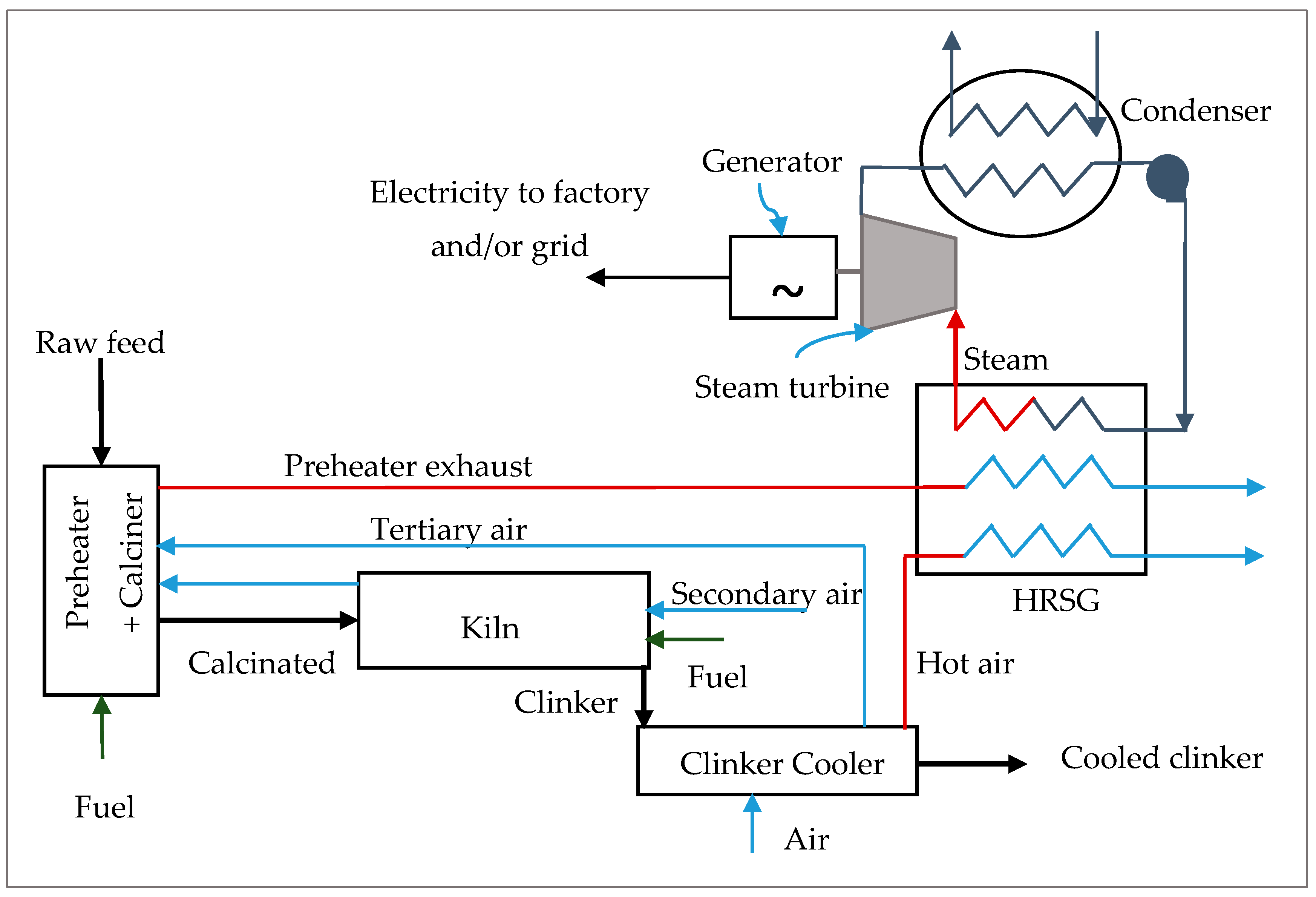Potential and Impacts of Cogeneration in Tropical Climate Countries: Ecuador as a Case Study
Abstract
1. Introduction and Literature Review
2. Materials and Methods
2.1. Methodology
2.1.1. Data Collection and Energy Consumption Baseline
2.1.1.1. Electricity Consumption Baseline
- (1)
- Elementary schools, high schools, colleges/universities, government buildings and offices at a national or municipal level where, as previously mentioned, due to climate conditions in Ecuador, there is no necessity of cogeneration intending, for example, indoor heating (which is common in temperate places) or water heating.
- (2)
- Construction and civil engineering companies (e.g., roads construction companies) that report high electricity consumption (for example for reducing the particle size of rocks).
2.1.1.2. Fuel Consumption Baseline
2.1.1.3. Final List of Industrial Companies That Could Adopt Cogeneration
2.1.2. Classification of Companies by Clusters and Validation of Data
2.1.3. Selection of Cogeneration Technologies
- (1)
- The proposed cogeneration/trigeneration system must fit into the current plant’s requirements of heat (e.g., steam and/or hot water necessities) or cold fluids (including A/C) to guarantee cogeneration plants with high capacity factors. Therefore, the plant requirement of thermal energy with heating and/or cooling effect defined the cogeneration/trigeneration capacity of the plant.
- (2)
- The prime mover selected will allow one to cover the electricity requirements totally or partially. In the case of deficit of electricity, and as long as the thermal energy production is met, it is preferred to import electricity from the national grid. If the cogeneration system produces electricity surplus, then it can be sold to the national grid. No sell or purchase of hot/cold fluids (i.e., transport of these fluids from or to the plant) were considered.
- (3)
- The type of fuel (e.g., biomass, biogas, NG, diesel, heavy oil) proposed for cogeneration should be readily available in the place the cogeneration plant will be located. Therefore, fuel availability is a key component for deciding on the technology proposed.
- (4)
- The yearly average thermal energy requirements (not the peak requirements) were used for sizing the cogeneration/trigeneration plant.
- (5)
- No indoor heating and/or district heating are required. This is expected due to geographical location [75].
- (6)
- The selection of the prime movers considered the limitations imposed by geographical conditions, specifically altitude. For the case study, industrial plants in the Ecuadorian Andes highlands are located at approximately 2500 m above the sea level (m.a.s.l.); thus, in these places, it is preferred to use diesel engines, gas engines, or boiler and steam turbines instead of gas turbines to guarantee adequate levels of efficiency of the cogeneration plant [76,77,78].
- (7)
- The selection of the prime movers also considered possible partial loads requirements (i.e., the ability to vary thermal and electrical output depending on hourly requirements, or the necessity for frequent stopping and starting). Consequently, diesel and/or gas engines are preferable for cogeneration instead of gas turbines or steam turbines coupled with boilers in companies that do not operate 24/7. Diesel and gas engines, additionally, are able to run with renewable fuels (biodiesel and biogas, respectively), which are expected to be available in the country in the future [79] (See Section 3.2).
- (8)
- Trigeneration can be projected only in industrial plants where air conditioning and/or process cooling fluids (above the water freezing temperature) for the industrial process are required. In this case, both air conditioning and/or cold fluids will be produced by using residual heat from the prime mover. The trigeneration system will mostly work on LiBr (lithium bromide) absorption equipment for air conditioning in the Coastal region and, in some cases, hotels, hospitals, and airports in the Andean highlands. Ammonia (NH3) absorption systems are proposed only when fluids with low temperatures are required for the industrial process (e.g., for pasteurization in the beverages, food, and dairy industries). Freezing is not part of the proposed trigeneration systems.
2.1.4. Computation of the Potential of Cogeneration of Ecuador
- Identify the location of the industrial plant and the availability of electricity grids to ensure interconnection to import/export electricity when electricity deficit/surplus exists.
- Collect/verify data on electrical and thermal loads and types of fuels used. This information was compared with the data from the ARCONEL and the ARCH (Section 2.1.1).
- Gather data on the company’s process: types of products, heat requirements (e.g., steam or hot gases) and other fluids used (e.g., cold fluids, air conditioning, hot water).
- Identify types of fuels that are or could be available in the company (or plant) location place.
- Select the appropriate cogeneration prime mover and the corresponding fuel.
- Compute the cogeneration plant capacity, based on the necessities of thermal energy. Table 4 presents equipment parameters used for the computations.
- Standardize the size of the equipment suggested for a specific company by using catalogues from companies that provide equipment for cogeneration/trigeneration (e.g., boilers, diesel engines, gas engines, steam turbines, HRSGs, and absorption chillers).
- Compute the amount of fuel that the cogeneration/trigeneration plant will require (Appendix B).
- Compute the amount of electricity that will be produced by the prime movers in the operating conditions of the cogeneration plant and how much of this electricity will be available for exporting to the national grid (if surplus electricity is available).
2.1.5. Assessment of Impacts of Cogeneration in Ecuador
2.1.5.1. Environmental Impacts
- (a)
- Emissions in cogeneration plants
- (b)
- Emissions avoided by replacing thermal power plants
2.1.5.2. Economic Impacts
2.1.5.3. Social Impacts
3. Results and Discussion
3.1. Current Electricity Demand and Fuel Consumption in the Industrial Sector of Ecuador
3.2. Cogeneration Technology by Type of Industry
3.3. Potential of Cogeneration/Trigeneration
3.4. Impacts of Cogeneration in Ecuador
3.4.1. Fuel Consumption, Improvement of Energy Efficiency, and GHG Emissions Reduction
3.4.2. Economic Analysis
3.4.3. Social Impacts of Cogeneration
4. Conclusions
Author Contributions
Funding
Acknowledgments
Conflicts of Interest
Appendix A. Schematics of Proposed Cogeneration Systems




Appendix B. Main Equations Used for the Computation of Cogeneration Systems (Units Are Presented in Brackets)
- (a)
- Cogeneration plant efficiency (CHPeff)CHPeff = (power output + useful heat recovered)/energy in fuel
- (b)
- Energy in fuel (Qfuel)Qfuel = mfuel*LHVfuel [kW]mfuel—fuel rate [kg/s]LHVfuel—fuel lower heating value [kJ/kg]
- (c)
- Energy in steam (Qsteam)Qsteam = msteam*(hsteam − hwater) [kW]msteam—flow rate (production) of steam [kg/s]hsteam—enthalpy of steam at the boiler exit [kJ/kg]hwater—enthalpy of water at the entrance of boiler [kJ/kg]
- (d)
- Efficiency of boiler [ƞboiler]ƞboiler = Qsteam/Qfuel
- (e)
- Energy in combustion gases (Qcgas) that is used, for instance, in a heat recovery steam generator (HRSG)Qcgas = mcgas*(hhotgas − hcoldgas) [kW]mcgas—flow rate of combustion gases [kg/s] (e.g., gases from gas engine)hhotgas—enthalpy of combustion gases at the entrance of heat recovery unit [kJ/kg]holdgas—enthalpy of combustion gases after passing through the heat recovery equipment [kJ/kg]
- (f)
- Electric energy efficiency of prime movers (motors) (ƞEE)ƞEE = Welec/QfuelWelec—electric power (useful energy output) [kW]
- (g)
- Heat recovery unit (HRU) efficiency (ƞHRU) for water heatingƞHRU = QHRUactual/QHRUtheorQHRUactual—actual heat transfer rate [kJ/s]QHRUtheor—maximum possible heat transfer rate [kJ/s]QHRUactual = mwaterHRU * (hwaterHRUent − hwaterHRUexit)mwaterHRU—water flow rate in the HRU [kg/s]hwaterHRUexit—enthalpy of water at the entrance of the HRU [kJ/kg]hwaterHRUent—enthalpy of water at the exit of the HRU [kJ/kg]
- (h)
- Heat recovery steam generator efficiency (ƞHRSG) (for steam production)ƞHRSG = QHRSGactual/QHRSGtheorQHRSGactual—actual heat transfer rate [kJ/s]QHRSGheor—maximum possible heat transfer rate [kJ/s]QHRSGactual = msteamHRSG * (hsteamHRSGent − hwaterHRSGexit)mwaterHRU—steam (or water) flow rate in the HRSG [kg/s]hwaterHRUexit—enthalpy of water at the entrance of the HRSG [kJ/kg]hsteamHRUent—enthalpy of steam at the exit of the HRSG [kJ/kg]
- (i)
- Efficiency of absorption chiller (COPAchill)COPAchill = Qevap/QinQevap—rate at which water is cooled by the evaporator [kJ/s]Qin—heat input (rate of heat loss from exhaust gas or steam that are used by the absorption unit) [kJ/s]
- (j)
- Electricity produced by steam turbine-generator (Egen) [kWh/month]Egen = Qsteam*ƞturb*ƞgen*Toper*pf [kWh/month]ƞturb—steam turbine efficiencyƞgen—generator efficiencyToper—time generator operates [h/month]
- (k)
- Present worth (present value) (Ct) of C monetary unitsCt = C/(1+i)t;i—discount rate; t—number of time periods
- (l)
- Net present value (NPV)NPV = (C1+C2+C3+ … + Cn)C1, C2, C3, …, Cn – Present worth of anticipated cash flows
References
- BP STATS. Statistical Review of World Energy Statistical Review of World, 68th ed.; BP: London, UK, 2019. [Google Scholar]
- Ackerman, F.; Stanton, E.A. Climate risks and carbon prices: Revising the social cost of carbon. Economics 2012. [Google Scholar] [CrossRef]
- Moore, F.C.; Diaz, D.B. Erratum: Temperature impacts on economic growth warrant stringent mitigation policy. Nat. Clim. Chang. 2015, 5, 280. [Google Scholar] [CrossRef]
- Dell, M.; Jones, B.F.; Olken, B.A. Temperature shocks and economic growth: Evidence from the last half century. Am. Econ. J. Macroecon. 2012. [Google Scholar] [CrossRef]
- Peláez-Samaniego, M.R.; Garcia-Perez, M.; Cortez, L.A.B.; Oscullo, J.; Olmedo, G. Energy sector in Ecuador: Current status. Energy Policy 2007. [Google Scholar] [CrossRef]
- Pelaez-Samaniego, M.R.; Riveros-Godoy, G.; Torres-Contreras, S.; Garcia-Perez, T.; Albornoz-Vintimilla, E. Production and use of electrolytic hydrogen in Ecuador towards a low carbon economy. Energy 2014, 64, 626–631. [Google Scholar] [CrossRef]
- Ponce-Jara, M.A.; Castro, M.; Pelaez-Samaniego, M.R.; Espinoza-Abad, J.L.; Ruiz, E. Electricity sector in Ecuador: An overview of the 2007–2017 decade. Energy Policy 2018, 113. [Google Scholar] [CrossRef]
- BID; Ministerio de Electricidad y Energía Renovable; MEER. Plan Nacional de Eficiencia Energética 2016–2035; Ministerio de Electricidad y Energía Renovable: Quito, Ecuador, 2017. [Google Scholar]
- Insituto de Investigación Geológico y Energético (IIGE). Balance Energético Nacional 2018; Ministerio de Energía y Recursos Naturales no Renovables: Quito, Ecuador, 2019. [Google Scholar]
- MAE. Resumen del Inventario Nacional de Gases de Efecto Invernadero del Ecuador. Available online: https://info.undp.org/docs/pdc/Documents/ECU/06%20Resumen%20Ejecutivo%20INGEI%20de%20Ecuador.%20Serie%20Temporal%201994-2012.pdf (accessed on 20 May 2019).
- MEER; BID. Plan Nacional de Eficiencia Energética; Ministerio de Electricidad y Energía Renovable: Quito, Ecuador, 2016. [Google Scholar]
- Posso, F.; Sánchez, J.; Espinoza, J.L.; Siguencia, J. Preliminary estimation of electrolytic hydrogen production potential from renewable energies in Ecuador. Int. J. Hydrogen Energy 2016, 41, 2326–2344. [Google Scholar] [CrossRef]
- ARCONEL. Balance Nacional de Energía Eléctrica. Available online: https://www.regulacionelectrica.gob.ec/balance-nacional/ (accessed on 20 December 2019).
- CENACE. Energía Neta Producida por las Centrales de Generación. Available online: http://www.cenace.org.ec/docs/Produción-de-Energía-(GWh)-mensual.htm (accessed on 12 March 2020).
- MEER; ARCONEL. Plan Maestro de Electrificación 2016–2025; Ministerio de Electricidad y Energía Renovable: Quito, Ecuador, 2017. [Google Scholar]
- Nzotcha, U.; Kenfack, J. Contribution of the wood-processing industry for sustainable power generation: Viability of biomass-fuelled cogeneration in Sub-Saharan Africa. Biomass Bioenergy 2019. [Google Scholar] [CrossRef]
- Arshad, M.; Ahmed, S. Cogeneration through bagasse: A renewable strategy to meet the future energy needs. Renew. Sustain. Energy Rev. 2016. [Google Scholar] [CrossRef]
- Deshmukh, R.; Jacobson, A.; Chamberlin, C.; Kammen, D. Thermal gasification or direct combustion? Comparison of advanced cogeneration systems in the sugarcane industry. Biomass Bioenergy 2013. [Google Scholar] [CrossRef]
- Dias, M.O.S.; Modesto, M.; Ensinas, A.V.; Nebra, S.A.; Filho, R.M.; Rossell, C.E.V. Improving bioethanol production from sugarcane: Evaluation of distillation, thermal integration and cogeneration systems. Energy 2011. [Google Scholar] [CrossRef]
- Salem Szklo, A.; Soares, J.B.; Tolmasquim, M.T. Energy consumption indicators and CHP technical potential in the Brazilian hospital sector. Energy Convers. Manag. 2004. [Google Scholar] [CrossRef]
- Restuti, D.; Michaelowa, A. The economic potential of bagasse cogeneration as CDM projects in Indonesia. Energy Policy 2007. [Google Scholar] [CrossRef]
- To, L.S.; Seebaluck, V.; Leach, M. Future energy transitions for bagasse cogeneration: Lessons from multi-level and policy innovations in Mauritius. Energy Res. Soc. Sci. 2018. [Google Scholar] [CrossRef]
- Gongora, A.; Villafranco, D. Sugarcane bagasse cogeneration in Belize: A review. Renew. Sustain. Energy Rev. 2018. [Google Scholar] [CrossRef]
- Deepchand, K. Commercial scale cogeneration of bagasse energy in Mauritius. Energy Sustain. Dev. 2001. [Google Scholar] [CrossRef]
- Rincón, L.E.; Becerra, L.A.; Moncada, J.; Cardona, C.A. Techno-economic analysis of the use of fired cogeneration systems based on sugar cane bagasse in south eastern and mid-western regions of Mexico. Waste Biomass Valoriz. 2014. [Google Scholar] [CrossRef]
- Booneimsri, P.; Kubaha, K.; Chullabodhi, C. Increasing power generation with enhanced cogeneration using waste energy in palm oil mills. Energy Sci. Eng. 2018. [Google Scholar] [CrossRef]
- Nasution, M.A.; Herawan, T.; Rivani, M. Analysis of palm biomass as electricity from palm oil mills in north sumatera. Energy Procedia 2014, 47, 166–172. [Google Scholar] [CrossRef]
- Garcia-Nunez, J.A.; Rodriguez, D.T.; Fontanilla, C.A.; Ramirez, N.E.; Silva Lora, E.E.; Frear, C.S.; Stockle, C.; Amonette, J.; Garcia-Perez, M. Evaluation of alternatives for the evolution of palm oil mills into biorefineries. Biomass Bioenergy 2016. [Google Scholar] [CrossRef]
- Simo, A.; Siyam Siwe, S. Availability and conversion to energy potentials of wood-based industry residues in Cameroon. Renew. Energy 2000. [Google Scholar] [CrossRef]
- Mujeebu, M.A.; Jayaraj, S.; Ashok, S.; Abdullah, M.Z.; Khalil, M. Feasibility study of cogeneration in a plywood industry with power export to grid. Appl. Energy 2009. [Google Scholar] [CrossRef]
- Duval, Y. Environmental impact of modern biomass cogeneration in Southeast Asia. Biomass Bioenergy 2001. [Google Scholar] [CrossRef]
- Coelho, S.T.; Velázquez, S.G.; Zylbersztajn, D. Cogeneration in Brazilian Pulp and Paper Industry from Biomass-Origin to Reduce CO2 Emissions. In Developments in Thermochemical Biomass Conversion; Bridgwater, A.V., Boocock, D.G.B., Eds.; Springer: Dordrecht, The Netherlands, 1997. [Google Scholar]
- Coronado, C.R.; Yoshioka, J.T.; Silveira, J.L. Electricity, hot water and cold water production from biomass. Energetic and economical analysis of the compact system of cogeneration run with woodgas from a small downdraft gasifier. Renew. Energy 2011. [Google Scholar] [CrossRef]
- Udomsri, S.; Martin, A.R.; Martin, V. Thermally driven cooling coupled with municipal solid waste-fired power plant: Application of combined heat, cooling and power in tropical urban areas. Appl. Energy 2011. [Google Scholar] [CrossRef]
- Mahlia, T.M.I.; Chan, P.L. Life cycle cost analysis of fuel cell based cogeneration system for residential application in Malaysia. Renew. Sustain. Energy Rev. 2011, 15, 416–426. [Google Scholar] [CrossRef]
- Silva, H.C.N.; Dutra, J.C.C.; Costa, J.A.P.; Ochoa, A.A.V.; dos Santos, C.A.C.; Araújo, M.M.D. Modeling and simulation of cogeneration systems for buildings on a university campus in Northeast Brazil—A case study. Energy Convers. Manag. 2019. [Google Scholar] [CrossRef]
- IDEA. Análisis del Potencial Cogeneración de Alta Eficiencia en España 2010–2015–2020; Instituto para la Diversificación y Ahorro de la Energía: Madrid, Spain, 2016.
- NSW. Office of Environment and Heritage NSW, Cogeneration Feasibility Guide; Sidney, 2014. Available online: https://www.environment.nsw.gov.au/resources/business/140685-cogeneration-feasibility-guide.pdf (accessed on 20 January 2018).
- Alexis, G.K.; Liakos, P. A case study of a cogeneration system for a hospital in Greece. Economic and environmental impacts. Appl. Therm. Eng. 2013. [Google Scholar] [CrossRef]
- Renedo, C.J.; Ortiz, A.; Mañana, M.; Silió, D.; Pérez, S. Study of different cogeneration alternatives for a Spanish hospital center. Energy Build. 2006. [Google Scholar] [CrossRef]
- Fabrizio, E. Feasibility of polygeneration in energy supply systems for health-care facilities under the Italian climate and boundary conditions. Energy Sustain. Dev. 2011. [Google Scholar] [CrossRef]
- Armanasco, F.; Colombo, L.P.M.; Lucchini, A.; Rossetti, A. Techno-economic evaluation of commercial cogeneration plants for small and medium size companies in the Italian industrial and service sector. Appl. Therm. Eng. 2012. [Google Scholar] [CrossRef]
- Sugiartha, N.; Chaer, I.; Marriott, D.; Tassou, S.A. Combined heating refrigeration and power system in food industry. J. Energy Inst. 2008. [Google Scholar] [CrossRef]
- Bianco, V.; De Rosa, M.; Scarpa, F.; Tagliafico, L.A. Implementation of a cogeneration plant for a food processing facility. A case study. Appl. Therm. Eng. 2016. [Google Scholar] [CrossRef]
- Gonzales Palomino, R.; Nebra, S.A. The potential of natural gas use including cogeneration in large-sized industry and commercial sector in Peru. Energy Policy 2012. [Google Scholar] [CrossRef]
- Arteconi, A.; Brandoni, C.; Polonara, F. Distributed generation and trigeneration: Energy saving opportunities in Italian supermarket sector. Appl. Therm. Eng. 2009. [Google Scholar] [CrossRef]
- Fantozzi, F.; Ferico, S.D.; Desideri, U. Study of a cogeneration plant for agro-food industry. Appl. Therm. Eng. 2000. [Google Scholar] [CrossRef]
- Szklo, A.S.; Tolmasquim, M.T. Strategic cogeneration-Fresh horizons for the development of cogeneration in Brazil. Appl. Energy 2001. [Google Scholar] [CrossRef]
- Bechara, R.; Gomez, A.; Saint-Antonin, V.; Schweitzer, J.M.; Maréchal, F. Methodology for the optimal design of an integrated sugarcane distillery and cogeneration process for ethanol and power production. Energy 2016. [Google Scholar] [CrossRef]
- Jenjariyakosoln, S.; Gheewala, S.H.; Sajjakulnukit, B.; Garivait, S. Energy and GHG emission reduction potential of power generation from sugarcane residues in Thailand. Energy Sustain. Dev. 2014. [Google Scholar] [CrossRef]
- Husain, Z.; Zainal, Z.A.; Abdullah, M.Z. Analysis of biomass-residue-based cogeneration system in palm oil mills. Biomass Bioenergy 2003. [Google Scholar] [CrossRef]
- Oliveira, R.C.d.; Silva, R.D.d.S.e; Tostes, M.E.D.L. A methodology for analysis of cogeneration projects using oil palm biomass wastes as an energy source in the Amazon. DYNA 2015. [Google Scholar] [CrossRef]
- Wu, Q.; Qiang, T.C.; Zeng, G.; Zhang, H.; Huang, Y.; Wang, Y. Sustainable and renewable energy from biomass wastes in palm oil industry: A case study in Malaysia. Int. J. Hydrogen Energy 2017. [Google Scholar] [CrossRef]
- Arrieta, F.R.P.; Teixeira, F.N.; Yáñez, E.; Lora, E.; Castillo, E. Cogeneration potential in the Columbian palm oil industry: Three case studies. Biomass Bioenergy 2007, 31, 503–511. [Google Scholar] [CrossRef]
- Pradeep Varma, G.V.; Srinivas, T. Design and analysis of a cogeneration plant using heat recovery of a cement factory. Case Stud. Therm. Eng. 2015, 5, 24–31. [Google Scholar] [CrossRef]
- Cardona, E.; Piacentino, A. A methodology for sizing a trigeneration plant in mediterranean areas. Appl. Therm. Eng. 2003, 23, 1665–1680. [Google Scholar] [CrossRef]
- Costa, M.H.A.; Balestieri, J.A.P. Comparative study of cogeneration systems in a chemical industry. Appl. Therm. Eng. 2001. [Google Scholar] [CrossRef]
- Dillingham, G. Combined Heat and Power (CHP) in Breweries—Better Beer at Lower Costs; U.S. Department of Energy: Washington, DC, USA, 2016; pp. 1–37.
- Freschi, F.; Giaccone, L.; Lazzeroni, P.; Repetto, M. Economic and environmental analysis of a trigeneration system for food-industry: A case study. Appl. Energy 2013. [Google Scholar] [CrossRef]
- Chicco, G.; Mancarella, P. Assessment of the greenhouse gas emissions from cogeneration and trigeneration systems. Part I: Models and indicators. Energy 2008. [Google Scholar] [CrossRef]
- Darabadi Zareh, A.; Khoshbakhti Saray, R.; Mirmasoumi, S.; Bahlouli, K. Extensive thermodynamic and economic analysis of the cogeneration of heat and power system fueled by the blend of natural gas and biogas. Energy Convers. Manag. 2018. [Google Scholar] [CrossRef]
- Su, B.; Han, W.; Chen, Y.; Wang, Z.; Qu, W.; Jin, H. Performance optimization of a solar assisted CCHP based on biogas reforming. Energy Convers. Manag. 2018. [Google Scholar] [CrossRef]
- CEN-CENELC. Manual for Determination of Combined Heat and Power (CHP); CEN: Brussels, Belgium, 2004. [Google Scholar]
- Cho, W.; Lee, K.S. A simple sizing method for combined heat and power units. Energy 2014. [Google Scholar] [CrossRef]
- Howard, B.; Saba, A.; Gerrard, M.; Modi, V. Combined heat and power’s potential to meet New York city’s sustainability goals. Energy Policy 2014. [Google Scholar] [CrossRef]
- Gambini, M.; Vellini, M. High efficiency cogeneration: Performance assessment of industrial cogeneration power plants. Energy Procedia 2014. [Google Scholar] [CrossRef]
- Kavvadias, K.C.; Tosios, A.P.; Maroulis, Z.B. Design of a combined heating, cooling and power system: Sizing, operation strategy selection and parametric analysis. Energy Convers. Manag. 2010. [Google Scholar] [CrossRef]
- Liu, M.; Shi, Y.; Fang, F. Combined cooling, heating and power systems: A survey. Renew. Sustain. Energy Rev. 2014. [Google Scholar] [CrossRef]
- Al Moussawi, H.; Fardoun, F.; Louahlia-Gualous, H. Review of tri-generation technologies: Design evaluation, optimization, decision-making, and selection approach. Energy Convers. Manag. 2016. [Google Scholar] [CrossRef]
- Sanaye, S.; Meybodi, M.A.; Shokrollahi, S. Selecting the prime movers and nominal powers in combined heat and power systems. Appl. Therm. Eng. 2008. [Google Scholar] [CrossRef]
- Shelar, M.N.; Bagade, S.D.; Kulkarni, G.N. Energy and Exergy Analysis of Diesel Engine Powered Trigeneration Systems. Energy Procedia 2016. [Google Scholar] [CrossRef]
- GIZ; BMZ. Micro y Pequeña Cogeneración y Trigeneración en México; GIZ Mexico: Mexico City, Mexico, 2013. [Google Scholar]
- United Nations. United Nations Statistical Division International Standard Industrial Classification of All Economic Activities (ISIC); Rev.4; United Nations: New York, NY, USA, 2008; ISBN 9789211615180. [Google Scholar]
- INE. Clasificación Nacional de Actividades Económicas; Instituto Nacional de Estadistica: Madrid, Spain, 2012. [Google Scholar]
- Carvalho, M.; Serra, L.M.; Lozano, M.A. Geographic evaluation of trigeneration systems in the tertiary sector. Effect of climatic and electricity supply conditions. Energy 2011. [Google Scholar] [CrossRef]
- Chaker, M.; Meher-Homji, C.B.; Mee, T.; Nicolson, A. Inlet Fogging of Gas Turbine Engines-Detailed Climatic Analysis of Gas Turbine Evaporative Cooling Potential. In Proceedings of the ASME Turbo Expo, New Orleans, LA, USA, 4–7 June 2001. [Google Scholar]
- Santoianni, D. Power plant performance under extreme ambient conditions. WÄRTSILÄ Tech. J. 2015, 1, 22–27. [Google Scholar]
- USEPA. Catalogue of CHP Technologies. U.S. Environmental Protection Agency Combined Heat and Power Partnership. Available online: https://www.epa.gov/sites/production/files/2015-07/documents/catalog_of_chp_technologies.pdf (accessed on 14 December 2017).
- MAGAP. Ecuador Marca su Rumbo en la Industria de los Agrocombustibles. Available online: https://www.agricultura.gob.ec/ecuador-marca-su-rumbo-en-la-industria-de-los-agrocombustibles/ (accessed on 15 May 2020).
- Hyman, L.B.; Meckel, M. Sustainable On-Site CHP Systems; Meckler, M., Hyan, L., Eds.; McGraw Hill: New York, NY, USA, 2010. [Google Scholar]
- IEA. CO2 Emissions from Fuel Combustion. Statistics; OCD Publishing: Paris, France, 2017. [Google Scholar] [CrossRef]
- Black & Vetch. Cost and Performance Data for Power Generation Technologies; Black & Vetch: Overland Park, KS, USA, 2012. [Google Scholar]
- IRENA. Renewable Power Generation Costs in 2014. Available online: www.irena.org/publications (accessed on 20 June 2017).
- Midwest Application CHP Center; Avalon Consulting. Combined Heat and Power (CHP) Resource Guide, 2nd ed.; University of Illinois at Chicago–Energy Resource Center: Chicago, IL, USA, 2005. [Google Scholar]
- GIZ. Cogeneration & Trigeneration—How to Produce Energy Efficiently; GIZ: Bonn, Germany, 2016. [Google Scholar]
- Petroecuador Subsidio Proyectado Por Producto Del 11 De Septiembre Al 10 De Octubre De 2020. Available online: https://www.eppetroecuador.ec/wp-content/uploads/downloads/2020/09/PRODUCTOS-SUBSIDIADOS-SEPTIEMBRE-2020-COMERCIAL-11-AL-10.pdf (accessed on 18 September 2020).
- Arne, O.; Schlag, N.; Patel, K.; Kwok, G. Capital Cost Review of Generation Technologies; Energy and Environmental Economics Inc.: San Francisco, CA, USA, 2014. [Google Scholar]
- UNEP; SETAC. Guidelines for Social Life Cycle Assesment of Products; Benoît, C., Mazijn, B., Eds.; UNEP/SETAC: Druk in de weer, Belgium, 2009; ISBN 978-92-807-3021-0. [Google Scholar]
- Rafiaani, P.; Kuppens, T.; Dael, M.V.; Azadi, H.; Lebailly, P.; Passel, S.V. Social sustainability assessments in the biobased economy: Towards a systemic approach. Renew. Sustain. Energy Rev. 2018. [Google Scholar] [CrossRef]
- Contreras-Lisperguer, R.; Batuecas, E.; Mayo, C.; Díaz, R.; Pérez, F.J.; Springer, C. Sustainability assessment of electricity cogeneration from sugarcane bagasse in Jamaica. J. Clean. Prod. 2018. [Google Scholar] [CrossRef]
- Siebert, A.; Bezama, A.; O’Keeffe, S.; Thrän, D. Social life cycle assessment indices and indicators to monitor the social implications of wood-based products. J. Clean. Prod. 2018. [Google Scholar] [CrossRef]
- Salgado Torres, R. Plan Maestro de Electricidad 2019–2027; Ministerio de Electricidad y Energía Renovable: Quito, Ecuador, 2019. [Google Scholar]
- COGEN Europe. Cogeneration Country Fact Sheet GERMANY; COGEN Europe: Brussels, Belgium, 2014. [Google Scholar]
- Mercados, E. Análisis de la Industria de Cogeneración en España; COGEN Espana: Madrid, Spain, 2010. [Google Scholar]
- DOE; EPA. Combined Heat and Power: A Clean Energy Solution; United States Environmental Protection Agency: Washington, DC, USA, 2012.
- Raineri, R.; Dyner, I.; Goñi, J.; Castro, N.; Olaya, Y.; Franco, C. Latin America Energy Integration: An Outstanding Dilemma. In Evolution of Global Electricity Markets: New Paradigms, New Challenges, New Approaches; Elsevier: Amsterdam, The Netherlands, 2013; ISBN 9780123978912. [Google Scholar]
- Corneille, F. Energy Integration in Latin America: The Connecting the Americas 2022 Initiative. Available online: http://www.ecpamericas.org/Blog/Default.aspx?id=134 (accessed on 3 January 2018).
- The Atlantic Council Regional Energy Integration: The Growing Role of LNG in Latin America. Available online: http://www.atlanticcouncil.org/events/webcasts/regional-energy-integration-the-growing-role-of-lng-in-latin-america (accessed on 22 January 2018).
- Bataille, C.; Melton, N. Energy efficiency and economic growth: A retrospective CGE analysis for Canada from 2002 to 2012. Energy Econ. 2017. [Google Scholar] [CrossRef]
- Tol, R.S. The Private Benefit of Carbon and Its Social Cost; Working Paper Series; Department of Economics, University of Sussex Business School: Sussex, UK, 2017. [Google Scholar]
- Khurana, S.; Banerjee, R.; Gaitonde, U. Energy balance and cogeneration for a cement plant. Appl. Therm. Eng. 2002, 22, 485–494. [Google Scholar] [CrossRef]

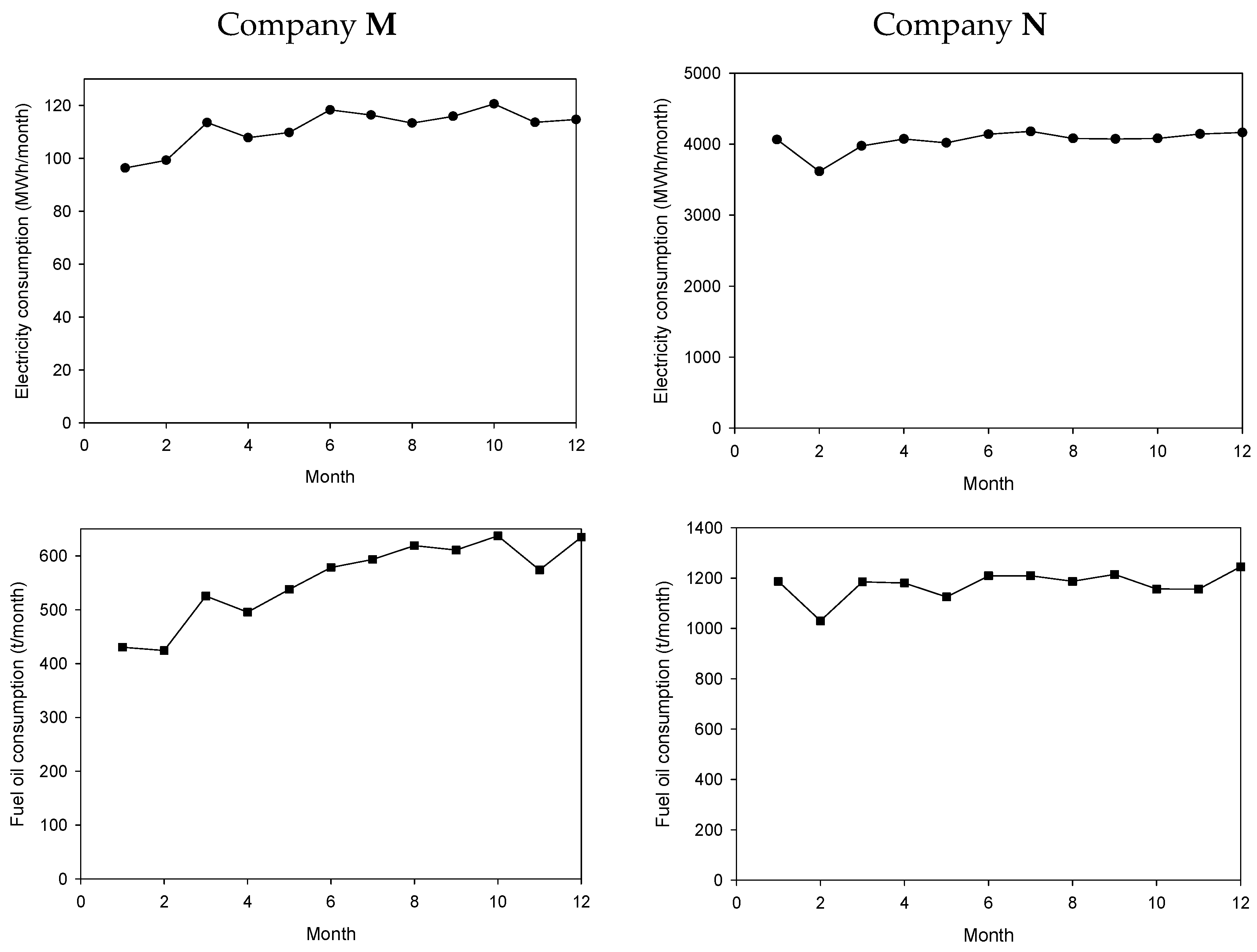

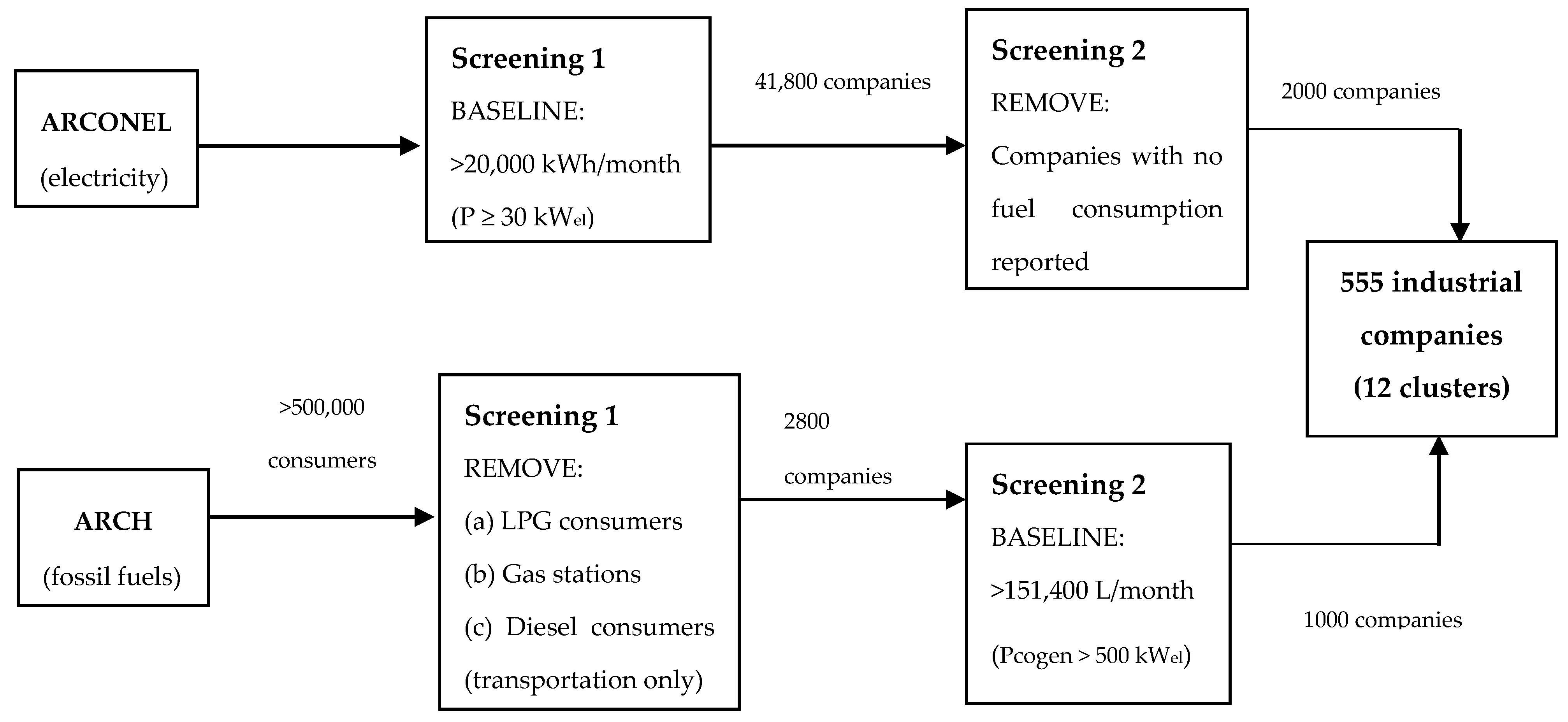

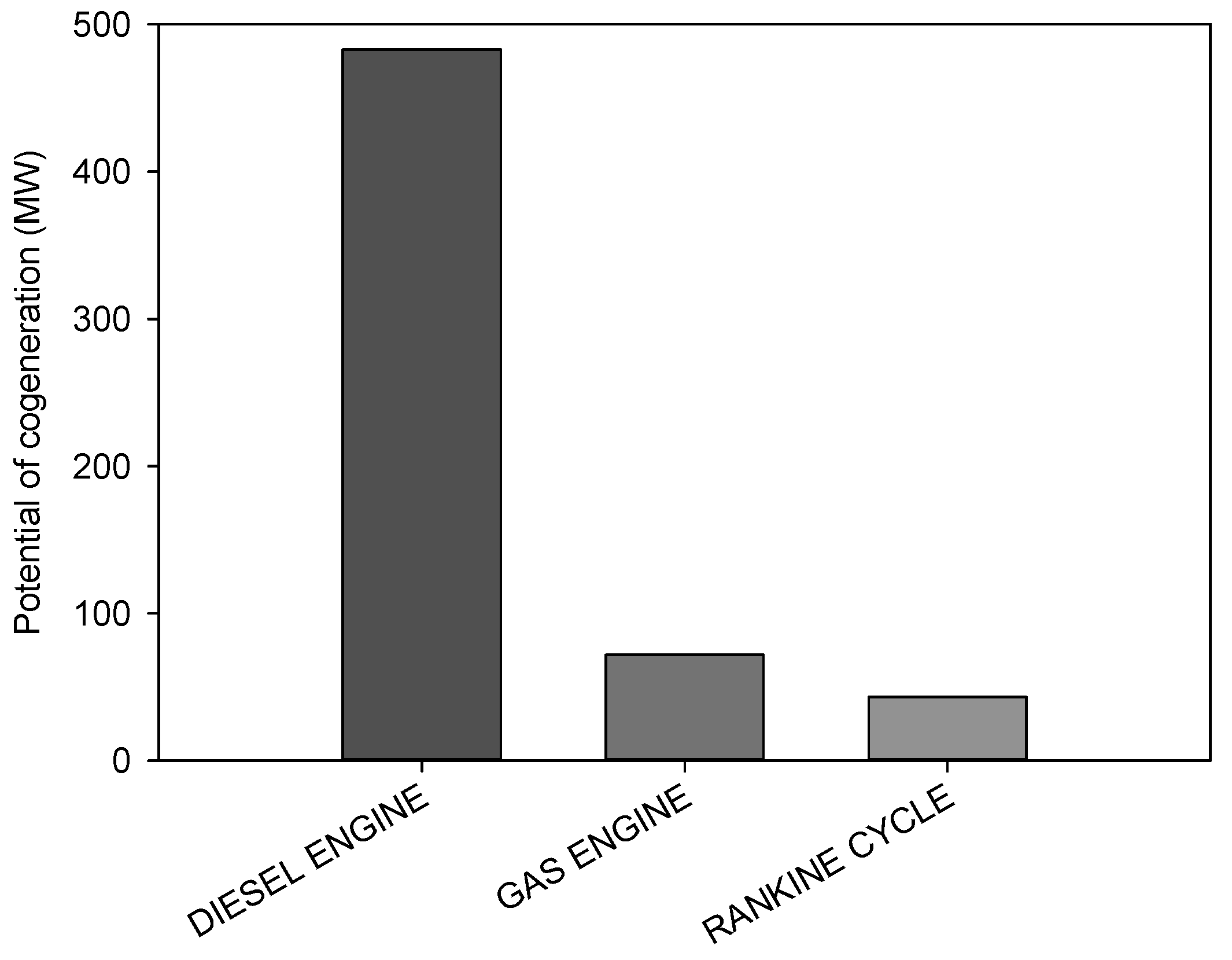
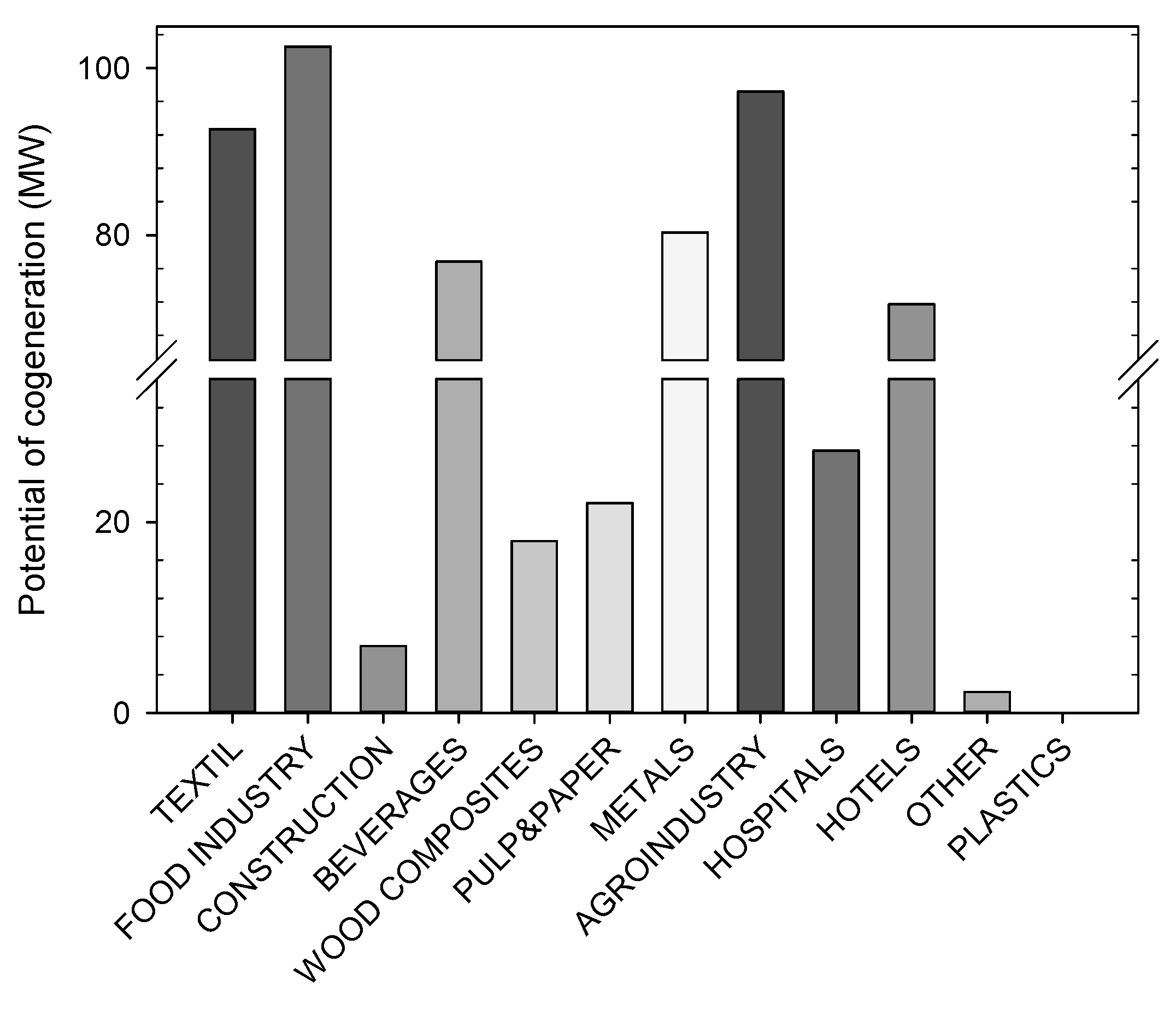
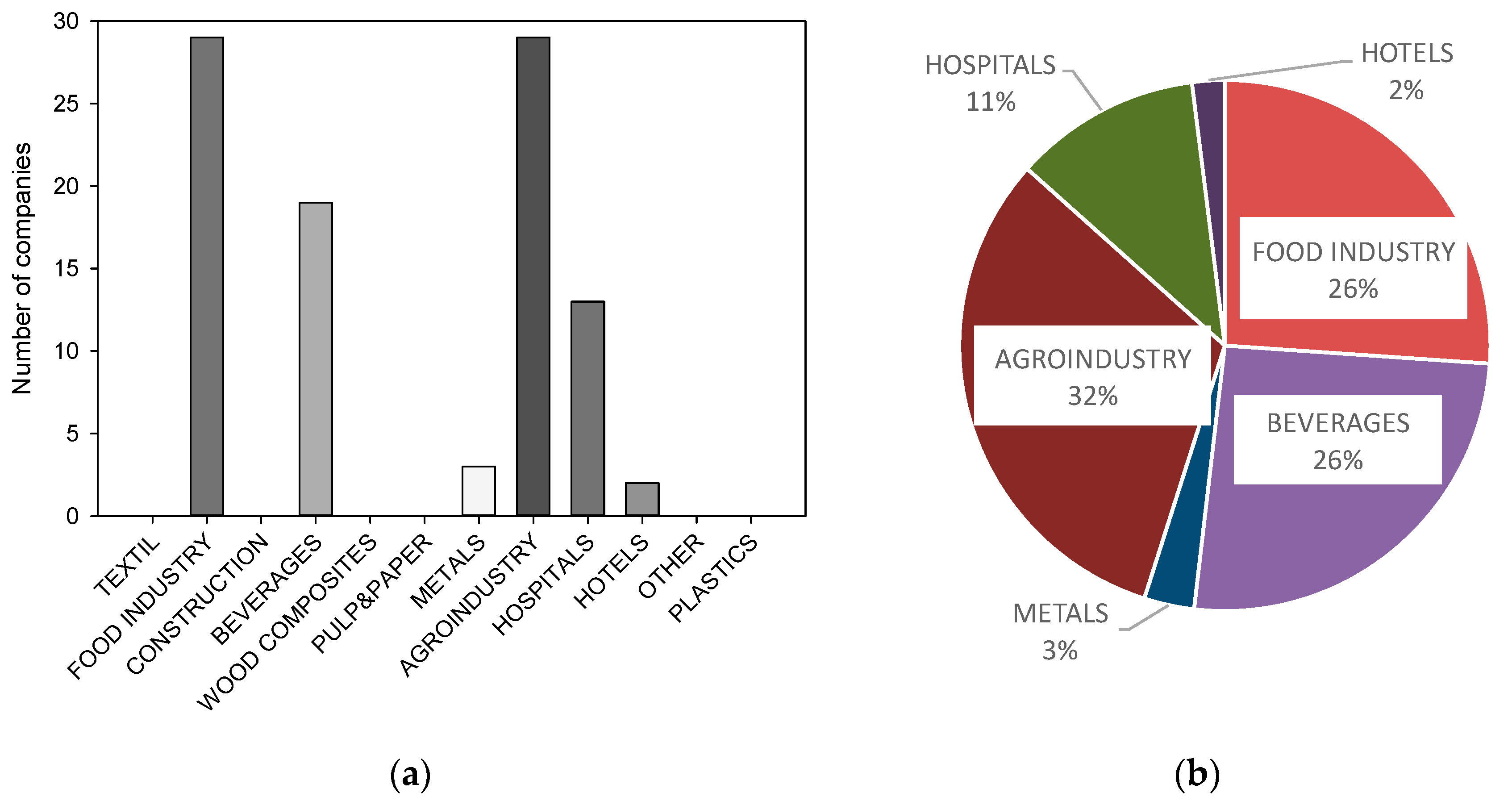
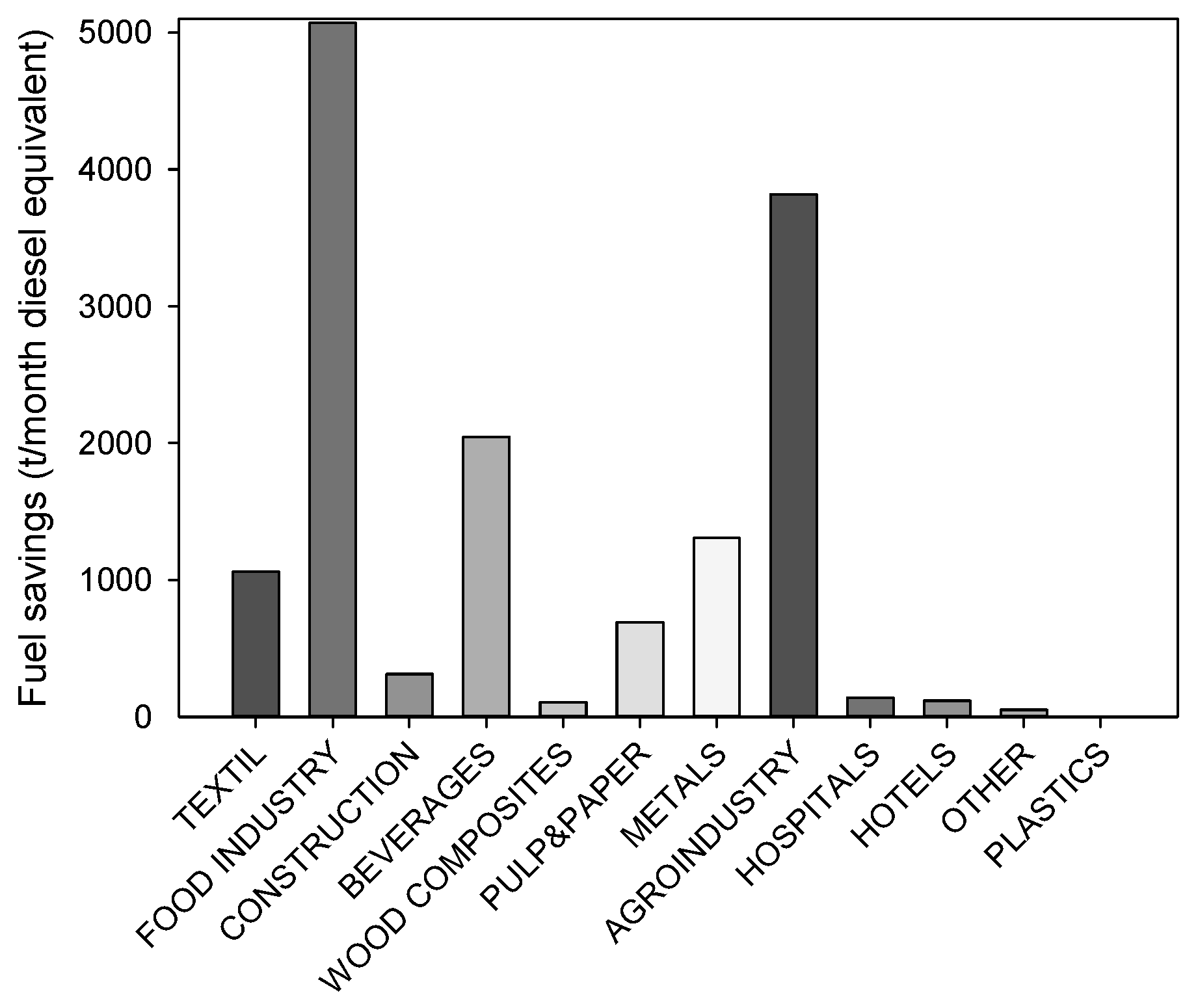
| Type of Industry | Technology /Process | Type of Fuel | Year Operation Started | Installed Capacity (MWel) | Electricity Generation (GWh/year) |
|---|---|---|---|---|---|
| Sugarcane industry | Rankine cycle (3 plants) | Sugarcane bagasse | 2004 | 136.6 | 408.3 |
| Food industry | Diesel engine (1 plant) | Diesel | 2007 | 1.0 | N/A |
| Oil palm industry | Rankine cycle (2 plants) | Oil palm solid residues | 1983 | 2.2 | N/A |
| Wood industry | Rankine cycle (1 plant) | Wood residues | 2003 | 1.0 | N/A |
| Oil refining | Rankine cycle (1 plant) | Fuel oil | N/A | 30.75 | N/A |
| Ethanol production | Rankine cycle (1 plant) | Fuel oil | N/A | 0.3 | N/A |
| TOTAL: | 172 MWel | ||||
| Type of Industry/Plant | Reference(s) |
|---|---|
| Hospitals | [39,40,41] |
| Small- and medium-sized industries and services | [42,43,44] |
| Large-sized industry and commercial sector | [45,46,47] |
| Sugarcane/ethanol | [17,18,19,21,22,23,24,25,48,49,50] |
| Oil palm | [27,28,31,51,52,53,54] |
| Wood and wood-derived products | [16,29,30,31,32,33] |
| Pulp and paper | [32] |
| Cement industry | [55] |
| Hotels | [56] |
| Chemical industry | [57] |
| Breweries | [58] |
| Food industry | [59] |
| Greenhouse gas emissions from cogeneration | [60] |
| Biogas/renewable energy | [61,62] |
| Others | [63,64,65,66,67,68,69,70,71] |
| No. | Classification ISIC | Cluster Name | Number of Companies | Number (and %) of Companies Visited | Predominant Work Fluid(s) |
|---|---|---|---|---|---|
| 1 | C13 | Textile industry | 56 | 15 (27%) | Steam, Hot gases |
| 2 | C23 | Construction materials (cement, ceramics/tiles) | 23 | 17 (74%) | Hot gases, Steam |
| 3 | C10 | Food industry (grain mills, fruit processing/juice, dairy, seafood, etc.) | 132 | 36 (27%) | Steam, Hot water, Cold water |
| 4 | C11 | Alcoholic and no-alcoholic beverages | 35 | 18 (51%) | Steam, Hot water, Cold water |
| 5 | C16 | Wood and wood composites | 5 | 2 (40%) | Steam, Hot gases |
| 6 | C17 | Pulp and paper | 22 | 6 (27%) | Steam, Hot gases |
| 7 | C24 y C25 | Metal processing industry | 29 | 10 (34%) | Hot gases |
| 8 | C20 | Agroindustry (includes oil palm industry) | 58 | 14 (24%) | Steam, Hot water |
| 9 | Q86 | Hospitals | 47 | 17 (36%) | Steam, Hot water, A/C *** |
| 10 | I55 | Hotels | 17 | 9 (53%) | Steam, Hot water, A/C |
| 11 | - | Others (chemical products, tires, glass, shopping malls, airports *, refineries **) | 63 | 15 (24%) | Steam, Hot water, A/C, Hot gases |
| 12 | C22 | Plastics | 68 | 3 (4.8%) | Hot water |
| TOTAL: | 555 | 162 (~30%) | |||
| Equipment and Type | Efficiency | Comments |
|---|---|---|
| Diesel engine | Up to 40% electric efficiency [78]) | Expected heat recovery: up to 86% from the total heat released by the engine (i.e., heat from exhaust gases and heat from jacket coolant), depending on the size of the engine. |
| Gas engine (working with biogas) | Up to 45% electric efficiency [78] | Expected heat recovery: up to 88% from the total heat released by the engine (i.e., heat from exhaust gases and heat from jacket coolant), depending on the size of the engine. |
| Steam turbine (back pressure) | ~55% [78] | |
| Heat recovery steam generator (HRSG) | 82% [80] | |
| Absorption chillers (single effect in all cases) * | Coefficient of performance, COP = 0.7 | LiBr absorption chillers for air conditioning and for producing cold fluids, except for low temperature fluids (close to 4 °C, where NH3 absorption chillers are suggested). |
| Biomass boilers | 75–80% | Depends on the capacity of the boiler. |
| Parameter | Details |
|---|---|
| Cost of both diesel and gas engines for cogeneration | USD 1,000,000/MWel * installed |
| Cost of equipment for Rankine cycle (boiler + steam turbine) | USD 3,000,000/MWel installed, from which, approximately 15% corresponds to the cost of the steam turbine and the rest to the boiler and auxiliary equipment and accessories [78,82,83] |
| Cost of HRSG | USD 300,000 per MWel of cogeneration capacity installed (this value is above that in [80], Ch. 24). |
| Cost of LiBr absorption chiller | USD 500/TR ** installed [80,84]. |
| Cost of NH3+H2O absorption chiller | USD 700/TR installed [84]. |
| Operation and maintenance costs | Value varies from 2% of the investment during the first years of the projects to up to 7% after year 10. Values are in the range of those reported by [85], although a little higher after year 5 due to the necessity of importing parts. |
| Expected capacity factor | 95% to 60%, depending on the type of industry (see Table 6). |
| discount rate (includes financial cost and financial risk) | 12% (rate currently used for electricity projects in Ecuador). |
| Reinvestment | 25% of the initial investment will be required on year 10. |
| Projects lifetime | 15 years. |
| Plant location and land requirements | No land will be bought for cogeneration plants since the plant will be installed at existing companies’ facilities. |
| Substation and transmission facilities | Cost is included in the cost of prime movers. |
| Insurance | 0.5% of the investment per year |
| Cost of diesel and natural gas | USD 2.12/gallon (USD ~0.57 US/L) and USD 0.45/kg, respectively (without subsidies) [86]. |
| Cost of biomass *** | USD 20/t, which is in the range of or above the costs of residues from the agroindustry (e.g., oil palm residues) in the Ecuadorian coast region (resulting from a field study). |
| Workforce salaries | Each cogeneration plant will require one employee per MWel installed per every 8 h of operation, with salaries of USD 1250/month (in the conditions of Ecuador), plus one supervisor and one person in charge of maintenance. |
| Type of Industry (Cluster) | Location of Company | Prime Mover Suggested | Range of Sizes | Expected Average Capacity Factor |
|---|---|---|---|---|
| Food industry: Dairy | Coastal region and Andean highlands | Internal combustion engine (diesel engine) | 0.75 to 2 MWel, using one or more engines | 75% |
| Food industry | Coastal region and Andean highlands | Internal combustion engine (diesel engine) or steam turbine (biomass fired boiler) | 0.5 to 5 MWel, using 1 or more engines | 80% |
| Textile industry | Andean highlands | Internal combustion engine (diesel engine) | 1 to 5 MWel, using normally more than 1 engine | 80% |
| Agroindustry (except oil palm industry) | Coastal region | Internal combustion engine (biogas or diesel engine) (4) | 0.5 to 3 MWel, using normally more than 1 engine | 80% |
| Agroindustry: Oil palm industry | Coastal region | Internal combustion engine (gas engine) (1) | 1 to 5 MWel, using normally more than 1 engine | 85% |
| Beverage industry | Coastal region and Andean highlands | Internal combustion engine (diesel engine) | 0.5 to 5 MWel, using 1 or more engines | 80% |
| Wood and wood composites industry | Andean highlands | Boiler (biomass fired) and steam turbine (Rankine cycle) (2) | 2 to 7 MWel | 85% |
| Cement and ceramic tiles | Coastal region and Andean highlands | Organic Rankine cycle | Up to 3 MWel | 80% |
| Pulp and paper | Coastal region and Andean highlands | Internal combustion engine (diesel engine) or biomass fired boiler (steam turbine) (3) | 0.5 to 3 MWel | 90% |
| Metals | Coastal region and Andean highlands | Organic Rankine cycle | 0.9 to 1.25 MWel | 80% |
| Hospitals | Coastal region and Andean highlands | Internal combustion engine (diesel engine) | 0.5 to 5 MWel, using normally more than 1 engine | 60% |
| Hotels | Coastal region and Andean highlands | Internal combustion engine (diesel engine) | 0.5 to 3.75 MWel, using normally more than 1 engine | 60% |
| Other: Airports | Coastal region and Andean highlands | Internal combustion engine (diesel engine) | 0.6 to 3 MWel, using normally more than 1 engine | 65% |
| Other: Shopping malls | Coastal region and Andean highlands | Internal combustion engine (diesel engine) | 2 MWel | 65% |
| Other: Tires | Andean highlands | Rankine cycle | ~1.2 MWel | 95% |
| Type of Fuel | Potential of Cogeneration (MWel) and Share in the Total (%) | Amount of Fuel | Expected Electricity Generation (GWh/year) | Potential GHG Emissions (tCO2/year) |
|---|---|---|---|---|
| Diesel | 482.9 (81%) | 368,950,000 kg/year | 4231.3 | +1,150,500 (a) |
| Biogas | 60.0 (10%) | 100,126,800 kg/year | 525.7 | −704,147 (b) |
| Biomass | 43.0 (7%) | 71,781,943 kg/year | 376.9 | −227,770 |
| Natural Gas | 11.9 (2%) | 19,772,571 kg/year | 102.9 | +62,210 |
| TOTAL: | 598 | 5236.8 | 280,793 (Total 1) | |
| Emissions in the SNI | −576,800 | |||
| Net GHG (reduction) | −296,007 (Total 2) | |||
| Type of Cluster of Industries | Type of Fuel Suggested | Type of Plant | Expected Cost of Electricity Generated (USD/kWh) |
|---|---|---|---|
| Oil palm industry | Biomass | Cogeneration | 0.09 |
| Oil palm industry | Biogas | Cogeneration | 0.02 |
| Dairy industry | Diesel | Trigeneration | 0.14 |
| Dairy industry | NG | Trigeneration | 0.06 |
| Textile industry | Diesel | Cogeneration | 0.13 |
| Textile industry | Biomass | Cogeneration | 0.10 |
| Hotels | Diesel | Trigeneration | 0.12 |
| Hotels | NG | Trigeneration | 0.08 |
| Hospitals | Diesel | Trigeneration | 0.17 |
| Hospitals | NG | Trigeneration | 0.05 |
© 2020 by the authors. Licensee MDPI, Basel, Switzerland. This article is an open access article distributed under the terms and conditions of the Creative Commons Attribution (CC BY) license (http://creativecommons.org/licenses/by/4.0/).
Share and Cite
Pelaez-Samaniego, M.R.; Espinoza, J.L.; Jara-Alvear, J.; Arias-Reyes, P.; Maldonado-Arias, F.; Recalde-Galindo, P.; Rosero, P.; Garcia-Perez, T. Potential and Impacts of Cogeneration in Tropical Climate Countries: Ecuador as a Case Study. Energies 2020, 13, 5254. https://doi.org/10.3390/en13205254
Pelaez-Samaniego MR, Espinoza JL, Jara-Alvear J, Arias-Reyes P, Maldonado-Arias F, Recalde-Galindo P, Rosero P, Garcia-Perez T. Potential and Impacts of Cogeneration in Tropical Climate Countries: Ecuador as a Case Study. Energies. 2020; 13(20):5254. https://doi.org/10.3390/en13205254
Chicago/Turabian StylePelaez-Samaniego, Manuel Raul, Juan L. Espinoza, José Jara-Alvear, Pablo Arias-Reyes, Fernando Maldonado-Arias, Patricia Recalde-Galindo, Pablo Rosero, and Tsai Garcia-Perez. 2020. "Potential and Impacts of Cogeneration in Tropical Climate Countries: Ecuador as a Case Study" Energies 13, no. 20: 5254. https://doi.org/10.3390/en13205254
APA StylePelaez-Samaniego, M. R., Espinoza, J. L., Jara-Alvear, J., Arias-Reyes, P., Maldonado-Arias, F., Recalde-Galindo, P., Rosero, P., & Garcia-Perez, T. (2020). Potential and Impacts of Cogeneration in Tropical Climate Countries: Ecuador as a Case Study. Energies, 13(20), 5254. https://doi.org/10.3390/en13205254





